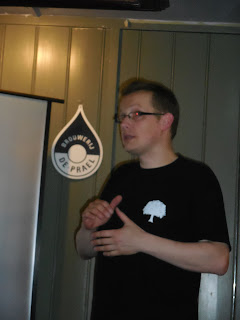David Quain kicked off talking about draught beer quality.
 |
| Winter is coming |
Though draught beer sales in general are falling it was heartening to hear that lager is in decline and cask beer is showing some growth.
The first problem are for draught beer quality was pythons, the chilled bundles of beer lines running from pub cellars to bars.
They're often build into pubs so are many years old, and can be up to 120m in length, containing eight pints of beer! Many people mistakenly clean beer lines aggressively but in frequently, rather than less aggressively but more often.
An old JIB paper, read at a meeting in 1911 chaired by Sydney O Neville, was quoted from at length to show how in many ways the same old problems with draught beer persist.
Though beer is microbiologically robust and pathogens won't grow in it sadly little attention if paid to beer hygiene. Worldwide there is only one set of draught beer standards: the German DIN. These say that less than 1,000 colony forming units/ml is good, 50,000 is unacceptable and 100,000 means need to line clean. Research in the on trade showed that these standards are not always reached.
Weekly line cleaning is recommended but this is not always carried out. Line cleaning has little or no mechanical action, one of the key parts of cleaning and biofilms can build up in beer lines. Problems also arrise if pubs have too many beers on tap as the less popular beers will have beer sitting in the lines for ages. It has been shown that less line cleaning equals less profit for the pub. Hot spots for contamination are fob detectors and keg couplers in the cellar and nozzles and the bar.
Nozzles are often removed at the end of the day and put in soda water. Strangely enough this isn't very good at killing bugs and line cleaner or sanitizing tablets work better.
Charlie Bamforth was next and he didn't have any slides or a recent article in the IBD mag so there'll be less pictures.
 |
| I drink and I know things |
Quality is driven from the top and he once had a boss that said two things matter: quality and people. Look after the people and they'll look after the quality.
Education is need to understand why things go wrong and Standard Operating Procedures are vital for consistency and making sure new staff can do the job. Everything needs to be documented and you need methodologies and measurements. The most important measurement though is taste, and you should taste everything.
Pumping beer around a brewery can cause problems with CO2 and DO2 levels. Sparging with CO2 to correct them will cause foaming, some of which will solidify and need filtering out or it will leave the beer with bits in it. DO2 should be below 100ppb, some places have got it to below 50.
If talking to bean counters about QA it's best to make it clear the cost implications:
1. QA and analysis costs.
2. Internal failures which need correcting costs.
3. External failures: beer in trade problems.
4. QA invests money in making sure things go right first time.
In spec. malt can still vary in taste: you need to specify how it's made not just the specs.
The one book he recommended everyone should read is Sierra Nevada boss Ken Grossman's Beyond The Pale.
There were questions at the end which lead to some interesting points on how to instil a culture of quality:
1. Pay people well.
2. People need to learn brewing science.
In the talk there were a lot more anecdotes, but I can't be arsed to type them all up. And anyway, with the Game of Thrones theme they should really have got Professor Graham Stewart down as his anecdotes had a much higher death rate. I'm sure most of them end with "of course he's dead now".
We didn't stick around after the talks as rather unfortunately for somewhere that was hosting beer quality talks the beer quality at Ubrew wasn't very good, and the prices were outrageous. I don't know if it's now their normal prices or if they were doing some price gouging for the night but the cheapest beer was £7 a pint and prices went up considerably from there. Paying £7 to £9 a pint for halves of variable quality beer served in plastic skiffs is not something I'm keen on.
























